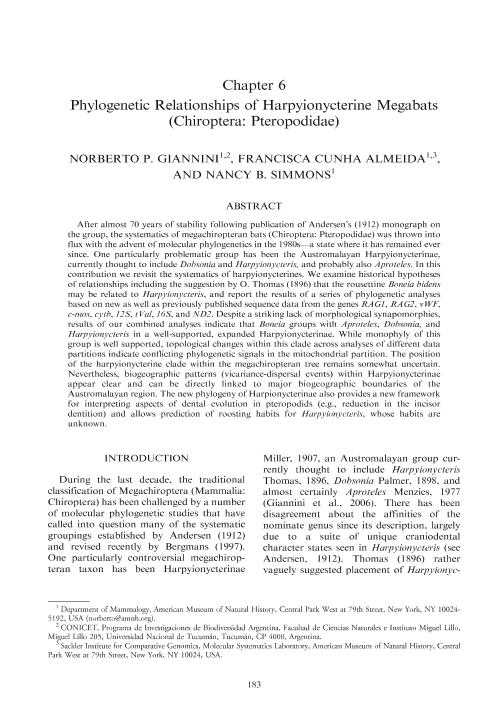Mostrar el registro sencillo del ítem
dc.contributor.author
Giannini, Norberto Pedro

dc.contributor.author
Cunha Almeida, Francisca

dc.contributor.author
Simmons, Nancy B.
dc.date.available
2019-04-30T14:39:59Z
dc.date.issued
2009-12
dc.identifier.citation
Giannini, Norberto Pedro; Cunha Almeida, Francisca; Simmons, Nancy B.; Phylogenetic Relationships of Harpyionycterine Megabats (Chiroptera: Pteropodidae); American Museum of Natural History; Bulletin of the American Museum of Natural History; 331; 1; 12-2009; 183-204
dc.identifier.issn
0003-0090
dc.identifier.uri
http://hdl.handle.net/11336/75316
dc.description.abstract
After almost 70 years of stability following publication of Andersen's (1912) monograph on the group, the systematics of megachiropteran bats (Chiroptera: Pteropodidae) was thrown into flux with the advent of molecular phylogenetics in the 1980s' a state where it has remained ever since. One particularly problematic group has been the Austromalayan Harpyionycterinae, currently thought to include Dobsonia and Harpyionycteris, and probably also Aproteles. In this contribution we revisit the systematics of harpyionycterines. We examine historical hypotheses of relationships including the suggestion by O. Thomas (1896) that the rousettine Boneia bidens may be related to Harpyionycteris, and report the results of a series of phylogenetic analyses based on new as well as previously published sequence data from the genes RAG1, RAG2, vWF, c-mos, cytb, 12S, tVal, 16S, and ND2. Despite a striking lack of morphological synapomorphies, results of our combined analyses indicate that Boneia groups with Aproteles, Dobsonia, and Harpyionycteris in a well-supported, expanded Harpyionycterinae. While monophyly of this group is well supported, topological changes within this clade across analyses of different data partitions indicate conflicting phylogenetic signals in the mitochondrial partition. The position of the harpyionycterine clade within the megachiropteran tree remains somewhat uncertain. Nevertheless, biogeographic patterns (vicariance-dispersal events) within Harpyionycterinae appear clear and can be directly linked to major biogeographic boundaries of the Austromalayan region. The new phylogeny of Harpionycterinae also provides a new framework for interpreting aspects of dental evolution in pteropodids (e.g., reduction in the incisor dentition) and allows prediction of roosting habits for Harpyionycteris, whose habits are unknown.
dc.format
application/pdf
dc.language.iso
eng
dc.publisher
American Museum of Natural History

dc.rights
info:eu-repo/semantics/openAccess
dc.rights.uri
https://creativecommons.org/licenses/by-nc-sa/2.5/ar/
dc.subject
Harpyionycterinae
dc.subject
Pteropodidae
dc.subject
Wallacea
dc.subject
Molecular Phylogeny
dc.subject.classification
Otras Ciencias Biológicas

dc.subject.classification
Ciencias Biológicas

dc.subject.classification
CIENCIAS NATURALES Y EXACTAS

dc.title
Phylogenetic Relationships of Harpyionycterine Megabats (Chiroptera: Pteropodidae)
dc.type
info:eu-repo/semantics/article
dc.type
info:ar-repo/semantics/artículo
dc.type
info:eu-repo/semantics/publishedVersion
dc.date.updated
2019-04-11T19:51:58Z
dc.journal.volume
331
dc.journal.number
1
dc.journal.pagination
183-204
dc.journal.pais
Estados Unidos

dc.journal.ciudad
Nueva York
dc.description.fil
Fil: Giannini, Norberto Pedro. Consejo Nacional de Investigaciones Científicas y Técnicas. Centro Científico Tecnológico - Tucumán. Unidad Ejecutora Lillo; Argentina. American Museum of Natural History; Estados Unidos. Universidad Nacional de Tucumán. Facultad de Ciencias Naturales e Instituto Miguel Lillo. Programa de Investigación de Biodiversidad Argentina; Argentina
dc.description.fil
Fil: Cunha Almeida, Francisca. American Museum of Natural History; Estados Unidos. Consejo Nacional de Investigaciones Científicas y Técnicas; Argentina
dc.description.fil
Fil: Simmons, Nancy B.. American Museum of Natural History; Estados Unidos
dc.journal.title
Bulletin of the American Museum of Natural History
dc.relation.alternativeid
info:eu-repo/semantics/altIdentifier/url/http://digitallibrary.amnh.org/dspace/bitstream/2246/6035/7/331-06-giannini.pdf
dc.relation.alternativeid
info:eu-repo/semantics/altIdentifier/doi/https://doi.org/10.1206/582-6.1
dc.relation.alternativeid
info:eu-repo/semantics/altIdentifier/url/https://bioone.org/journals/bulletin-of-the-american-museum-of-natural-history/volume-331/issue-1
Archivos asociados
